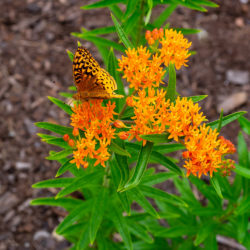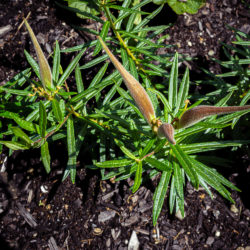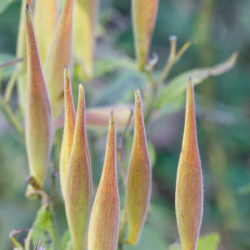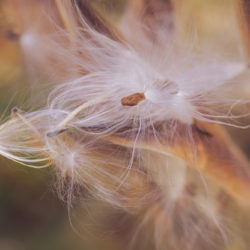Etymology
Asclepias is Greek for the god of healing; tuberosa is Latin and refers to enlarged root shape.
Native Habitat
Sunny, dry grasslands.
Garden Uses
Colorful, showy, low-maintenance flowers, excellent for sunny, dry to medium border or butterfly garden. Tolerates poor, dry soil, but subject to crown rot in poorly drained areas. Emerges later than many perennials, so mark placement. May self-seed, but generally does not transplant easily due to deep taproot. Both long-lived blooms and seed pods are attractive in bouquets. As with other milkweeds, it is subject to aphids.
Overview
A bushy, attractive perennial herb, with large flat-topped clusters of orange flowers, and abundant dark-green foliage. Unlike other milkweeds, this species has alternate leaves and a clear, rather than milky, sap. It is considered native to New England in sunny, dry grasslands, but is rare now in non-manmade settings and is protected in most states.
Leaves and Stems
Grows 1 to 3 feet tall. Leaves are deciduous, simple, alternate along the stem, and oblong to lanceolate. Leaf is smooth edged, with dark green top, and lighter beneath. Size range is 2 to 4 inches in length, 3/8 to 3/4 inches in width. Stems are fibrous, multi- branching, upright, red-green and hairy. Flowers grow at stem tips.
Flowers
Umbrella-like clusters (umbels), 2-5 inches across, made up of numerous, radially symmetrical, ¼ inch star-shaped, 5-petal flowers. Corolla, hoods, and horn are all bright orange and smooth. Rarely flowers are red or yellow.
Fruit/Seed
Narrow, spindle-shaped pods are 3 to 6 inches long, 1 - 2 inches wide, grayish green, and covered with short hairs. Split when dry to disperse hundreds of 1/8 inch brown seeds, each on a silky tassel for wind dispersal.
Wildlife Associates
Flowers are nectar source for multiple pollinators and hummingbirds, while leaves feed butterfly larva including monarchs (although this is not the milkweed preferred by monarchs; it appears to offer larvae less biochemical protection from predators than other species). Considered deer resistant.
Propagation
Grows easily from seed, but may take 2 to 3 years to establish and bear flowers. May also be propagated by root cuttings (2 inch sections cut from the taproot can be planted vertically in moistened soil in the autumn).
Ethnobotanical Uses
Its tough root was chewed by some First Nations people as a treatment for pleurisy and other pulmonary symptoms, though it is currently listed as poisonous.
Sources
Lady Bird Johnson Wildflower Center
Plant Profile by Kate O’Dell




